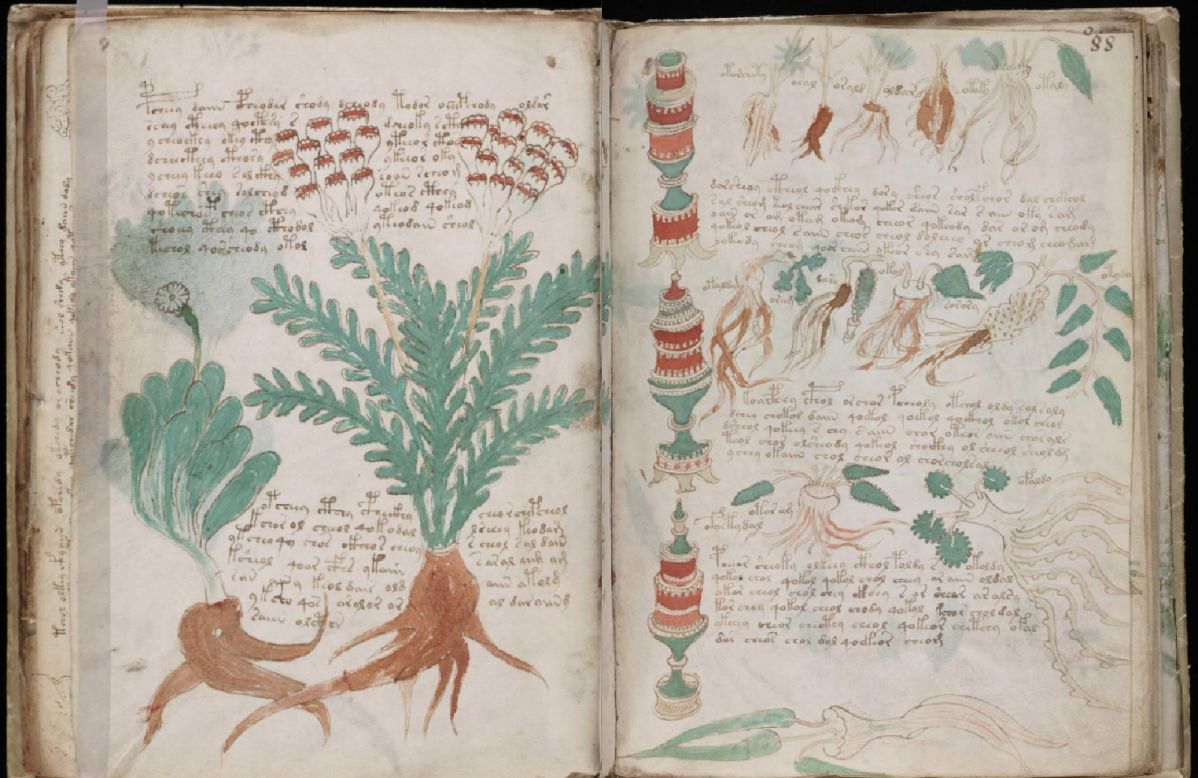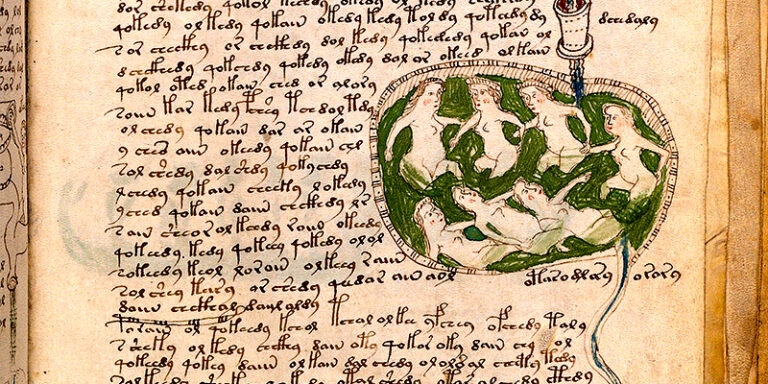Imagine stepping into a world of forgotten knowledge, where elegant but indecipherable script dances across vellum pages, accompanied by enigmatic illustrations depicting strange plants, unrecognizable constellations, and nude figures in enigmatic pools. This is the realm of the Voynich Manuscript, a book that has baffled, intrigued, and confounded scholars, codebreakers, and curious minds for centuries. Often heralded as the world’s most mysterious book, the Voynich Manuscript beckons us into a labyrinth of unknown language, uncharted history, and unanswered questions.
In this extraordinary journey through the ancient pages of the manuscript and the annals of history, we will delve deep into the conundrum of the Voynich Manuscript. We’ll explore its perplexing origins, retrace the footsteps of those who have sought to decipher its secrets and ponder the myriad theories and hypotheses surrounding its existence. As we venture into this enigmatic world, we must ask: Will the Voynich Manuscript ever relinquish its secrets to the relentless pursuit of human curiosity, or will its allure persist as a testament to the enduring mysteries that challenge our understanding of the past and the unknown?
The Enigmatic Codex

Our story begins with the mysterious manuscript itself—the Voynich Manuscript. It is a book like no other, measuring approximately 23.5 by 16.2 centimeters, and is believed to contain around 240 vellum pages. The vellum, a type of parchment made from animal skins, adds to the book’s aura of antiquity. But what truly sets it apart is its content.
The text within the Voynich Manuscript, written in an unknown script, remains undeciphered to this day. Its characters are flowing and elegant, resembling a language, yet they remain unintelligible. The manuscript is adorned with a series of vivid, colorful illustrations that depict unidentified plants, celestial bodies that defy modern astronomical knowledge, and bizarre scenes featuring nude women in various pools and landscapes.
For generations, the Voynich Manuscript has fascinated, frustrated, and mystified those who have attempted to decode it. Its pages are a veritable labyrinth of unknown symbols, offering no clues to their meaning. The text is organized into sections that resemble paragraphs, and there are headers throughout, suggesting the presence of structure, but the actual language—or code—eludes understanding.
The Journey Through Time
To understand the Voynich Manuscript’s journey through history, we must begin with its first confirmed appearance. In 1912, the manuscript was purchased by a rare book dealer and collector named Wilfrid Voynich, from whom it derives its name. Voynich discovered the book in the library of the Collegio Romano in Rome, Italy. The book was included in the estate of the library’s director, Athanasius Kircher, who had collected numerous unusual and cryptic texts.
The manuscript’s provenance before its appearance in the Collegio Romano remains a mystery, a blank page in its own story. While it has been dated to the early 15th century, its earlier history, including its authorship and purpose, remains shrouded in obscurity. This lack of historical context only adds to the intrigue surrounding the book.
Cryptographers, Codebreakers, and the Unsolved
Since the discovery of the Voynich Manuscript by Wilfrid Voynich, a parade of cryptographers, linguists, and scholars have attempted to decipher its secrets. The most famous among these was William F. Friedman, a renowned cryptanalyst who played a significant role in breaking the Japanese Purple Code during World War II.
Friedman’s foray into the Voynich Manuscript did not yield definitive results. Despite his best efforts and the application of advanced cryptographic techniques, the manuscript’s script remained unreadable. Over the years, other experts and amateur sleuths have tried their hand at deciphering the text, proposing a wide range of theories and hypotheses.
The manuscript has stubbornly resisted all attempts at decryption, frustrating even the most seasoned codebreakers. The text’s unknown language and script, which lacks any recognizable reference point in the history of human writing systems, have proved to be formidable obstacles.
Theories and Hypotheses
Theories abound about the Voynich Manuscript’s purpose and origins. One of the most widely accepted ideas is that it is a detailed treatise on herbal medicine. The illustrations, which feature various plants and herbs, appear to support this theory. However, without the ability to decipher the accompanying text, this remains speculative.
Other theories suggest that the manuscript could be a work of elaborate hoaxes or nonsense, designed to deceive or amuse. Some scholars propose that the manuscript may be a product of an unknown and extinct language. Others have ventured into more exotic territory, proposing that it is a guide to ancient alchemy or the knowledge of extraterrestrial civilizations.
The Manuscript’s Allure
The Voynich Manuscript’s enduring appeal lies not only in its enigmatic content but also in the questions it raises about human history, language, and knowledge. Its existence challenges our understanding of the past, inviting us to contemplate the possibility of lost civilizations and hidden wisdom.
The manuscript’s allure has transcended the world of academia, captivating the popular imagination and inspiring countless works of fiction, art, and music. It has appeared in novels, television shows, and movies, each time beckoning the audience to ponder the tantalizing notion of uncovering the ultimate secret.
The Future of the Enigma
As the Voynich Manuscript continues to perplex and enthrall, modern technology and interdisciplinary approaches have revitalized efforts to unlock its secrets. Scientists and historians have turned to cutting-edge tools such as multispectral imaging and deep learning algorithms to examine the manuscript’s pages. These endeavors have revealed hidden details, but the core of the mystery remains elusive.
While the manuscript’s code may someday yield its secrets to technology, artificial intelligence, or the sheer persistence of humanity, the Voynich Manuscript’s allure will persist. Its enigma will continue to beckon the curious, challenge the brilliant minds of cryptographers, and serve as a reminder of the vast depths of the unknown that still exist in our world.
A Timeless Enigma
As we navigate through the pages of the Voynich Manuscript and its enduring enigma, we find ourselves in the presence of a riddle that transcends time and space. This mysterious manuscript, filled with its flowing, unreadable script and captivating illustrations, is more than just a relic of the past—it is a symbol of our boundless curiosity and unquenchable thirst for discovery.
The Voynich Manuscript has stood the test of time, drawing curious minds into its intricate web for centuries. While its pages are ostensibly made of vellum, they are also woven with threads of wonder, mystery, and the unknown. The questions it raises go beyond its content; they extend to the very nature of human knowledge, history, and the inscrutable recesses of the past.
In an age characterized by the rapid dissemination of information and the seemingly boundless frontiers of exploration, the Voynich Manuscript is a poignant reminder that, despite our advances, the unknown still beckons. It remains a testament to the enduring power of enigma and the mysteries that continue to challenge the human intellect.
The allure of the manuscript has not been confined to the halls of academia. It has transcended boundaries and ignited the popular imagination, making appearances in novels, films, and other works of fiction. Each time the Voynich Manuscript is introduced to a new audience, it brings with it a tantalizing promise—a promise of uncovering the ultimate secret, of unraveling the riddle that has defied generations.
But in the heart of this enduring mystery lies a paradox. It is the very persistence of the Voynich Manuscript’s secrets that keeps it relevant and fascinating. With each passing day, new avenues of inquiry, innovative technologies, and interdisciplinary approaches breathe fresh life into the quest to unlock its meaning. The undeciphered text may one day yield to technology, artificial intelligence, or a brilliant codebreaker’s unrelenting pursuit.
Yet, paradoxically, even if the script were to be deciphered, the Voynich Manuscript would lose none of its allure. For its true power lies in the journey, the questions, and the pursuit of knowledge itself, rather than in the knowledge finally uncovered. The manuscript’s value is in its ability to engage, challenge, and captivate the curious minds that gaze upon it.
In a world of seemingly boundless information and technological advancement, the Voynich Manuscript invites us to step into the realm of the unknown and embrace the questions that have no immediate answers. It reminds us that, even as we push the boundaries of knowledge, there remain riddles that defy resolution, mysteries that continue to captivate, and enigmas that challenge our understanding of history, language, and the vast unknown.
In the end, the Voynich Manuscript is not just a cryptic book from the past, but a timeless symbol of the enduring human quest for understanding, the unending fascination with the unexplained, and the insatiable curiosity that drives us to explore, question, and wonder. Its place in history is secure as an enigma that has stood the test of time, a puzzle that remains unsolved, and a testament to the enduring allure of the unknown.

